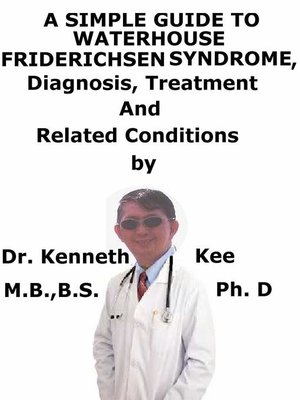A Simple Guide to Waterhouse-Friderichsen Syndrome, Diagnosis, Treatment and Related Conditions
ebook
By Kenneth Kee

Sign up to save your library
With an OverDrive account, you can save your favorite libraries for at-a-glance information about availability. Find out more about OverDrive accounts.
Find this title in Libby, the library reading app by OverDrive.



Search for a digital library with this title
Title found at these libraries:
| Library Name | Distance |
|---|---|
| Loading... |
This book describes Waterhouse-Friderichsen Syndrome, Diagnosis and Treatment and Related Diseases
Waterhouse-Friderichsen syndrome (WFS) is a cluster of symptoms happening from the failure of the adrenal glands to function normally as a effect of bleeding into the gland.
WFS are caused by serious infection with meningococcus bacteria or other bacteria, such as:
1. Group B streptococcus
2. Pseudomonas aeruginosa
3. Streptococcus pneumoniae
4. Staphylococcus aureus
Waterhouse-Friderichsen syndrome was first mentioned in cases of Neisseria meningitidis sepsis.
Over the years, several bacterial and viral causes have been linked, which are not limited to:
1. Streptococcus pneumonia
2. Hemophilus influenzae
3. Escherichia coli
4. Staphylococcus aureus
5. Group A beta-hemolytic Streptococcus
6. Capnocytophaga canimorsus
7. Enterobacter cloacae
8. Pasteurella multocida
9. Plesiomonas shigelloides
10. Neisseria gonorrhoeae
11. Moraxella duplex
Bilateral adrenal hemorrhage has also been mentioned with:
1. Rickettsia rickettsii
2. Bacillus anthracis
3. Treponema pallidum
4. Legionella pneumophila
5. Viral infections such as Cytomegalovirus, Parvovirus B19, Epstein-Barr virus, and Varicella zoster virus
In children who died due to sepsis and bilateral adrenal hemorrhage, Pseudomonas aeruginosa was the most frequent pathogen diagnosed.
N. meningitidis is the most frequent bacteria linked with adrenal hemorrhage
Other risk factors linked with WFS are:
1. The use of anticoagulants,
2. Thrombocytopenia,
3. Hypercoagulable states as heparin-induced thrombocytopenia, and antiphospholipid syndrome,
4. Trauma to the adrenals,
5. Postoperative state.
Trauma was the documented cause of adrenal hemorrhage 2.8% patients.
2.1% patients had adrenal hemorrhage linked with anticoagulant therapy
Adrenal hemorrhage was not common (5.4%, n=6) as a complication of chronic anticoagulation in patients receiving warfarin alone without antiplatelet therapy.
Symptoms can happen suddenly.
They are caused by the bacteria growing (multiplying) inside the body.
Symptoms are:
1. Fever and chills
2. Joint and muscle pain
3. Headache
4. Vomiting
On abdominal examination, abdominal rigidity or rebound tenderness may be evident.
WFS linked with meningococcemia typically shows:
1. Petechial rash,
2. Disseminated intravascular coagulation,
3. Purpura fulminans
The petechial rash normally forms on the trunk and lower portions of the body but can form over mucous membranes as well.
If the doctor suspects the infection is produced by meningococcus bacteria, other tests are:
1. Lumbar puncture to get a sample of spinal fluid for culture
2. Skin biopsy and Gram stain test of sample
Patients with Waterhouse Friderichsen syndrome manifest with sepsis.
A blood sample is taken, and the treatment started instantly before obtaining the results.
Antibiotics are given right away to treat the bacterial infection.
Glucocorticoid medicines will also be given to treat any adrenal gland insufficiency.
Supportive treatments will be required for other symptoms.
Hypoglycemia is treatable by infusing 2 to 4 ml/kg of 25% dextrose as a bolus.
TABLE OF CONTENT
Introduction
Chapter 1 Waterhouse-Friderichsen Syndrome
Chapter 2 Causes
Chapter 3 Symptoms
Chapter 4 Diagnosis
Chapter 5 Treatment
Chapter 6 Prognosis
Chapter 7 Adrenal Hemorrhage
Chapter 8 Life and Death of an Adrenal Gland







